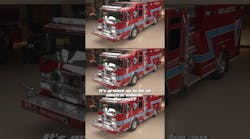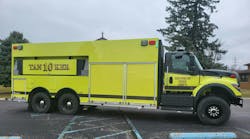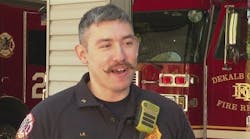What if, after some initial investigation, the truck committee is still not clear whether a midship or a rear-mount truck is correct for the department? It is difficult at best to assess the advantages and disadvantages of each by reading a detailed specification or reviewing a blueprint of the rig. While both documents provide valuable data on the configuration of the apparatus, they do not provide sufficient data to let a committee properly consider all of its the operational aspects.
Most reputable manufacturers build stock-model or demonstrator aerial devices that let sales personnel bring the apparatus directly to your community to enable the truck committee to view and operate the aerial device in your environment. There are many benefits to “test driving” the ladder apparatus that you might be considering, without having the obligation to purchase or specify any of the components that are on the demonstrator unit.
If you are unsure as to the type of apparatus, inquire if the manufacturer can bring in both a midship and a rear-mounted truck to be able to compare side by side, as to how each unit would set up and operate at buildings within your community. Notice the last part of the last sentence, “how each unit would set up and operate at buildings within your community.” Please take note it did not say go to the largest parking lot in town. Many, if not most, aerial demonstrations take place in parking lots and most of those demonstrations do not flow any water out of the ladder pipe or off the tower ladder basket. From a practical point of view, a demonstration like this is a waste of time because we do plan on flowing water and we do not have many parking lot fires.
We found this story to be interesting and very relevant: A small New England city was on the verge of trading its five engines and three ladders for four quints until at the eleventh hour, just prior to signing the purchasing contracts, someone said, “Let’s take one of those quints around town to make sure it will work.” They soon learned that these vehicles could cover only 20% of their city. The city still has five engines and three ladders.
Following are some suggestions as to how to make the most out of a demonstrator ladder truck visit to your department:
2. After confirming that the demo unit will fit into your station, park the rig inside to look at how much space is needed to house the truck. This is especially important if you are moving from a smaller aerial ladder to a larger or longer platform unit.
3. Prior to the arrival of the truck, map out a realistic road course through the community following normal response routes, to insure that the proposed truck will adequately maneuver in your first-due response area.
4. Set up the apparatus at several target hazards in the community to assess the working scrub area of the device and how much time and room is required to set up the outriggers to properly stabilize the truck.
5. If your community has one-way streets or other tight areas, set up the truck by short jacking to observe what practical limitations there are with the ladder device. Always use all of the required safety devices and only perform this operation with the supervision of the manufacturer’s representative.
6. Review the available body compartment space and ground ladder banking arrangements to see how they may or may not meet your department’s needs.
7. If the apparatus is equipped with a waterway or platform with master stream appliances, set up the apparatus in a location where you can supply the unit with water and operate the unit as a water tower. In this way you can verify some of the claims made in the specifications regarding water-flow capabilities and determine how the features of the aerial device may benefit your department.
These are just some of the aspects of a ladder truck demo that you may wish to consider when evaluating new apparatus for your department. After the truck committee has looked at several different makes and models of ladder trucks, it may then be helpful to put all of the important features and components on a spreadsheet to fairly compare each of the aerial units. Due to marketing strategies by each of the manufactures this may be a difficult task. They do not want you to compare apples to apples, but do not get discouraged – the time you spend now will pay big dividends in the long run. Taking digital photos of the important characteristics of each apparatus will assist later on when reviewing the various types of outrigger and aerial ladder controls that you were exposed to during this time.
One aspect of ladder truck design that greatly impacts operational performance is what type of options you can put at the end of the fly section on an aerial ladder. It is now possible to put waterway monitors, 12-volt and 120-volt lighting, electrical outlets, breathing air, tip controls and hydraulic outlets. While each these components may have some value, placing all of these items at the tip will inhibit the operation of the ladder when you need to make the roof, enter a window or perform some horizontal vent with the aerial ladder.
Be careful not to specify or buy “everything in the catalog” simply to have one of everything on your ladder truck. Many otherwise well-designed ladder trucks are rendered useless because of some of the unnecessary items that we purchase, just to make ourselves feel better or “keep up with the Joneses.” What your department ends up with by buying everything is a very expensive one-dimensional water tower that can shine an elevated light. Would it not be better to purchase a versatile vehicle that can perform rescue, ventilation, roof access, window access and yes even a water tower?
After concluding several aerial demonstrations in your community, the truck committee should have sufficient information to make an informed decision on the style and model of aerial equipment that best fits your needs. Aerial ladder apparatus should complement the balance of the fleet that is operated by the fire department. Properly designed and well-equipped apparatus will provide a measure of safety for the personnel in the fire department as well as for everyone in the community.
In the next installment, we will discuss some component and equipment items that you may wish to consider when developing specifications for your next aerial apparatus.
Tom Shand is a firefighter with the Newton-Abbott Volunteer Fire Department in the Town of Hamburg, NY, and a senior instructor at the Onondaga County Community College Public Safety Training Center. He is employed by American LaFrance and is assigned to the Hamburg Facility in the apparatus sales department. Michael Wilbur, a Firehouse® contributing editor, is a lieutenant in the New York City Fire Department, assigned to Ladder Company 27 in the Bronx, and has served for the past five years on the FDNY Apparatus Purchasing Committee. He has consulted on a variety of apparatus related issues throughout the country. For further information access his website at www.emergencyvehicleresponse.com.







